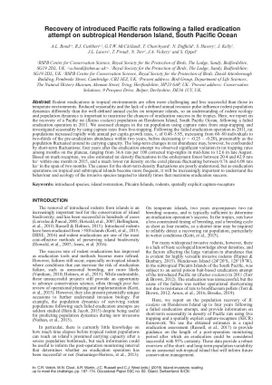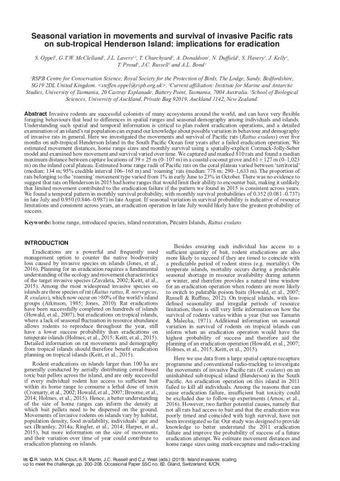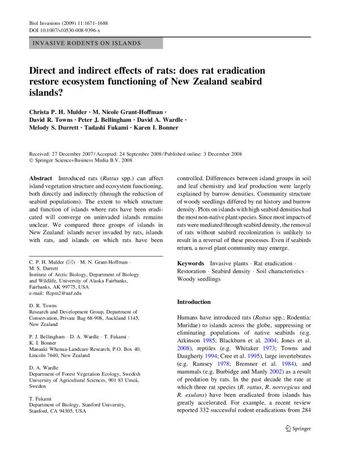Recovery of introduced Pacific rats following a failed eradication attempt on subtropical Henderson Island, South Pacific Ocean
- Description:
- Rodent eradications in tropical environments are often more challenging and less successful than those in temperate environments. Reduced seasonality and the lack of a defined annual resource pulse influence rodent population dynamics differently than the well-defined annual cycles on temperate islands, so an understanding of rodent ecology and population dynamics is important to maximise the chances of eradication success in the tropics. Here, we report on the recovery of a Pacific rat (Rattus exulans) population on Henderson Island, South Pacific Ocean, following a failed eradication operation in 2011. We assessed changes in the rat population using capture rates from snap-trapping and investigated seasonality by using capture rates from live-trapping. Following the failed eradication operation in 2011, rat populations increased rapidly with annual per capita growth rates, r, of 0.485.95, increasing from 6080 individuals to two-thirds of the pre-eradication abundance within two years, before decreasing (r = -0.25 -0.20), presumably as the population fluctuated around its carrying capacity. The long-term changes in rat abundance may, however, be confounded by short-term fluctuations: four years after the eradication attempt we observed significant variation in rat trapping rates among months on the plateau, ranging from 36.6 rats per 100 corrected trap-nights in mid-June to 12.6 in late August. Based on mark-recapture, we also estimated rat density fluctuations in the embayment forest between 20.4 and 42.9 rats ha-1 within one month in 2015, and a much lower rat density on the coral plateau fluctuating between 0.76 and 6.08 rats ha-1 in the span of two months. The causes for the short-term density fluctuations are poorly understood, but as eradication operations on tropical and subtropical islands become more frequent, it will be increasingly important to understand the behaviour and ecology of the invasive species targeted to identify times that maximise eradication success.
- Display date:
- 2019
- Collections:
- Secretariat of the Pacific Regional Environment Programme (SPREP)
- Publisher:
- Secretariat of the Pacific Regional Environment Programme (SPREP)
- Content partner:
- Secretariat of the Pacific Regional Environment Programme (SPREP)
- Availability:
- Not specified
-
Copyright status: All rights reservedFind out more about what you are able to do with this itemThis item is all rights reserved, with means you'll have to get permission from Secretariat of the Pacific Regional Environment Programme (SPREP) before using it. For more information, please see our use and reuse page.What can I do with this item?Non-infringing useNZ copyright law does not prevent every use of a copyright work, and this item may be hosted by an international institute or organisation. You should consider what you can and cannot do with a copyright work.No sharingYou may not copy and/or share this item with others without further permission. This includes posting it on your blog, using it in a presentation, or any other public use.No modifyingYou are not allowed to adapt or remix this item into any other works.No commercial useYou may not use this item commercially.
Related items
Welcome and warm Pasifik greetings
The information on this site has been gathered from our content partners.
The names, terms, and labels that we present on the site may contain images or voices of deceased persons and may also reflect the bias, norms, and perspective of the period of time in which they were created. We accept that these may not be appropriate today.
If you have any concerns or questions about an item, please contact us.


